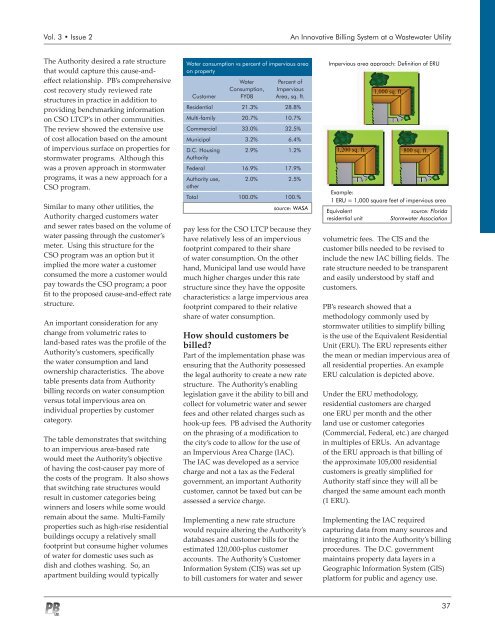ECONOMIC FORECASTING REVIEW - Parsons Brinckerhoff
ECONOMIC FORECASTING REVIEW - Parsons Brinckerhoff
ECONOMIC FORECASTING REVIEW - Parsons Brinckerhoff
You also want an ePaper? Increase the reach of your titles
YUMPU automatically turns print PDFs into web optimized ePapers that Google loves.
Vol. 3 • Issue 2<br />
An Innovative Billing System at a Wastewater Utility<br />
The Authority desired a rate structure<br />
that would capture this cause-andeffect<br />
relationship. PB’s comprehensive<br />
cost recovery study reviewed rate<br />
structures in practice in addition to<br />
providing benchmarking information<br />
on CSO LTCP’s in other communities.<br />
The review showed the extensive use<br />
of cost allocation based on the amount<br />
of impervious surface on properties for<br />
stormwater programs. Although this<br />
was a proven approach in stormwater<br />
programs, it was a new approach for a<br />
CSO program.<br />
Similar to many other utilities, the<br />
Authority charged customers water<br />
and sewer rates based on the volume of<br />
water passing through the customer’s<br />
meter. Using this structure for the<br />
CSO program was an option but it<br />
implied the more water a customer<br />
consumed the more a customer would<br />
pay towards the CSO program; a poor<br />
fit to the proposed cause-and-effect rate<br />
structure.<br />
An important consideration for any<br />
change from volumetric rates to<br />
land-based rates was the profile of the<br />
Authority’s customers, specifically<br />
the water consumption and land<br />
ownership characteristics. The above<br />
table presents data from Authority<br />
billing records on water consumption<br />
versus total impervious area on<br />
individual properties by customer<br />
category.<br />
The table demonstrates that switching<br />
to an impervious area-based rate<br />
would meet the Authority’s objective<br />
of having the cost-causer pay more of<br />
the costs of the program. It also shows<br />
that switching rate structures would<br />
result in customer categories being<br />
winners and losers while some would<br />
remain about the same. Multi-Family<br />
properties such as high-rise residential<br />
buildings occupy a relatively small<br />
footprint but consume higher volumes<br />
of water for domestic uses such as<br />
dish and clothes washing. So, an<br />
apartment building would typically<br />
Water consumption vs percent of impervious area<br />
on property<br />
Customer<br />
Water<br />
Consumption,<br />
FY08<br />
Percent of<br />
Impervious<br />
Area, sq. ft.<br />
Residential 21.3% 28.8%<br />
Multi-family 20.7% 10.7%<br />
Commercial 33.0% 32.5%<br />
Municipal 3.2% 6.4%<br />
D.C. Housing<br />
Authority<br />
2.9% 1.2%<br />
Federal 16.9% 17.9%<br />
Authority use,<br />
other<br />
2.0% 2.5%<br />
Total 100.0% 100.%<br />
<br />
source: WASA<br />
pay less for the CSO LTCP because they<br />
have relatively less of an impervious<br />
footprint compared to their share<br />
of water consumption. On the other<br />
hand, Municipal land use would have<br />
much higher charges under this rate<br />
structure since they have the opposite<br />
characteristics: a large impervious area<br />
footprint compared to their relative<br />
share of water consumption.<br />
How should customers be<br />
billed?<br />
Part of the implementation phase was<br />
ensuring that the Authority possessed<br />
the legal authority to create a new rate<br />
structure. The Authority’s enabling<br />
legislation gave it the ability to bill and<br />
collect for volumetric water and sewer<br />
fees and other related charges such as<br />
hook-up fees. PB advised the Authority<br />
on the phrasing of a modification to<br />
the city’s code to allow for the use of<br />
an Impervious Area Charge (IAC).<br />
The IAC was developed as a service<br />
charge and not a tax as the Federal<br />
government, an important Authority<br />
customer, cannot be taxed but can be<br />
assessed a service charge.<br />
Implementing a new rate structure<br />
would require altering the Authority’s<br />
databases and customer bills for the<br />
estimated 120,000-plus customer<br />
accounts. The Authority’s Customer<br />
Information System (CIS) was set up<br />
to bill customers for water and sewer<br />
Impervious area approach: Definition of ERU<br />
1,000 sq. ft.<br />
1,200 sq. ft. 800 sq. ft.<br />
Example:<br />
1 ERU = 1,000 square feet of impervious area<br />
Equivalent <br />
residential unit<br />
source: Florida<br />
Stormwater Association<br />
volumetric fees. The CIS and the<br />
customer bills needed to be revised to<br />
include the new IAC billing fields. The<br />
rate structure needed to be transparent<br />
and easily understood by staff and<br />
customers.<br />
PB’s research showed that a<br />
methodology commonly used by<br />
stormwater utilities to simplify billing<br />
is the use of the Equivalent Residential<br />
Unit (ERU). The ERU represents either<br />
the mean or median impervious area of<br />
all residential properties. An example<br />
ERU calculation is depicted above.<br />
Under the ERU methodology,<br />
residential customers are charged<br />
one ERU per month and the other<br />
land use or customer categories<br />
(Commercial, Federal, etc.) are charged<br />
in multiples of ERUs. An advantage<br />
of the ERU approach is that billing of<br />
the approximate 105,000 residential<br />
customers is greatly simplified for<br />
Authority staff since they will all be<br />
charged the same amount each month<br />
(1 ERU).<br />
Implementing the IAC required<br />
capturing data from many sources and<br />
integrating it into the Authority’s billing<br />
procedures. The D.C. government<br />
maintains property data layers in a<br />
Geographic Information System (GIS)<br />
platform for public and agency use.<br />
37
















